Pomona College
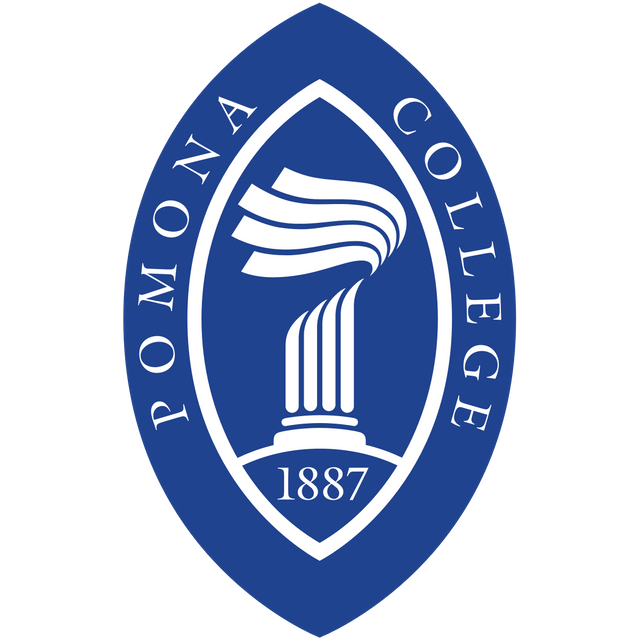
Pomona College

| Type | Private liberal arts college |
|---|---|
| Established | October 14, 1887 (1887-10-14) |
| Endowment | $2.274 billion (2018)[1] |
| Budget | $211 million[2] |
| President | G. Gabrielle Starr |
Academic staff | 240[3] |
Administrative staff | 271[4] |
| Undergraduates | 1,671[5] |
| Location | Claremont ,California ,United States |
| Campus | Suburban, 140 acres (57 ha) |
| Colors | Blue and gold[6] |
| Nickname | Sagehens |
Sporting affiliations | NCAA Division III – SCIAC |
| Mascot | Cecil the Sagehen |
| Website | www.pomona.edu [191] |
 | |
| University rankings | |
| National | |
| Forbes[99] | 12 |
| Times/WSJ[100] | 24 |
| Liberal arts colleges | |
| U.S. News & World Report[101] | 5 |
| Washington Monthly[102] | 18 |
Pomona College is a private liberal arts college in Claremont, California. It was founded in 1887 by a group of Congregationalists who wanted to recreate a "college of the New England type" in Southern California, and in the 1920s, it became the founding member of the Claremont Colleges consortium.
Pomona is a four-year undergraduate institution, and enrolled approximately 1,700 students representing all 50 states and 63 countries as of fall 2018.[7] The college offers 48 majors and 600 courses, though students have access to nearly 2000 additional courses at the other Claremont Colleges.[8] The college's 140-acre (57 ha) main campus is in a residential community near the foothills of the San Gabriel Mountains.
Pomona currently has the lowest acceptance rate of any U.S. liberal arts college (7.6% for the 2018 admissions cycle),[9][10] and is ranked among the top five liberal arts colleges in the country by Forbes, U.S. News & World Report, and The Wall Street Journal/Times Higher Education.[11][12][13] It has an endowment of $2.17 billion as of June 2017, giving it the seventh-highest endowment per student of any college or university in the U.S.[14][15] In 2018, Niche ranked Pomona as the most diverse college or university in the country; among enrolled students, 74% hail from out of state, 56% receive need-based financial aid, and 61% identify as a person of color or an international student.[16][17][18][19][20] The college is a top producer of Fulbright Scholars and other fellowships.[21][22][23][24]
| Type | Private liberal arts college |
|---|---|
| Established | October 14, 1887 (1887-10-14) |
| Endowment | $2.274 billion (2018)[1] |
| Budget | $211 million[2] |
| President | G. Gabrielle Starr |
Academic staff | 240[3] |
Administrative staff | 271[4] |
| Undergraduates | 1,671[5] |
| Location | Claremont ,California ,United States |
| Campus | Suburban, 140 acres (57 ha) |
| Colors | Blue and gold[6] |
| Nickname | Sagehens |
Sporting affiliations | NCAA Division III – SCIAC |
| Mascot | Cecil the Sagehen |
| Website | www.pomona.edu [191] |
 | |
| University rankings | |
| National | |
| Forbes[99] | 12 |
| Times/WSJ[100] | 24 |
| Liberal arts colleges | |
| U.S. News & World Report[101] | 5 |
| Washington Monthly[102] | 18 |
History
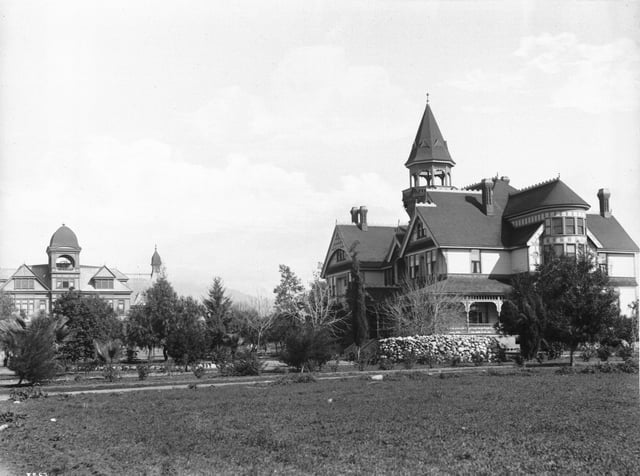
An exterior view of the college, 1907
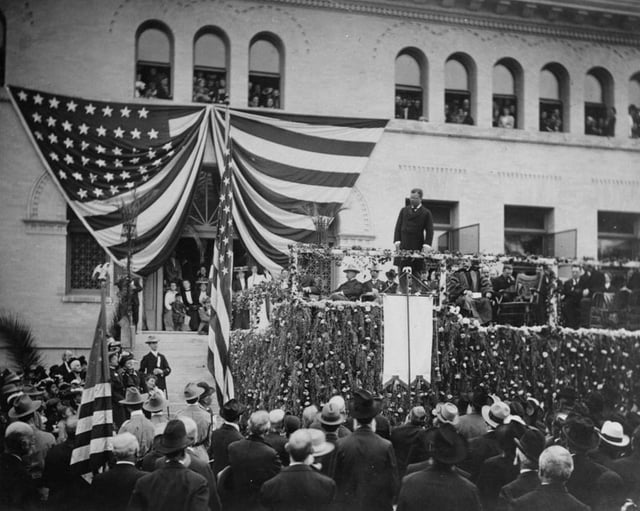
President Theodore Roosevelt speaks at Pomona, 1903
Pomona College was established as a coeducational institution on October 14, 1887, by a group of Congregationalists. The founders' goal was to create a college in the same mold as small New England institutions. The college was originally located in Pomona, California; classes first began in Ayer Cottage, a rental house, on September 12, 1888. The next year, the school moved to Claremont, at the site of an unfinished hotel. This building would eventually become Sumner Hall, the current location of Office of Admissions. The name Pomona College remained after the relocation. The college’s first graduating class, in 1894, had ten members.[25]
Its founders’ values led to the college’s belief in educational equity. Like other Congregationalist-founded colleges such as Harvard, Dartmouth, Middlebury, and Bowdoin, Pomona received its own governing board, ensuring its independence.[25] The board of trustees was originally composed of graduates of Williams, Dartmouth, Bates and Yale, among others, to help create "a college of the New England type."[26]
Although Pomona's first Asian and black students enrolled in 1897 and 1900 respectively, Pomona remained almost all-white throughout its early years.[27] Daily attendance at chapel was mandated until 1921, and a strong athletic culture and fraternity system developed.[27] During World War I, the college oriented itself towards the war effort.[27]
In the early 1920s, the college’s growth led its president, James A. Blaisdell, to call for "a group of institutions divided into small colleges—somewhat of an Oxford type—around a library and other utilities which they would use in common." This would allow Pomona to retain its small, liberal arts-focused teaching while gaining the resources of a larger university. On October 14, 1925, Pomona’s 38th anniversary, the Claremont Colleges were incorporated.[28][29] This decade also saw the construction of additional residential buildings on the campus north of 6th St.[27]
The college's enrollment declined during the Great Depression, and it once again oriented itself towards wartime activities during World War II.[27] From 1946 to 1956, the college ran a joint athletics program with Claremont Men's College.[27]
In 1970, Pomona's athletics program joined with Pitzer to create the Pomona-Pitzer Sagehens.[27] Throughout the 1980s and 1990s, the college added a variety of new buildings and its endowment grew steadily.[27] In 1991, the college converted the dormitory basements used by fraternities into lounges, hastening a lowering of the profile of Greek life on campus.[31]
By 1997, the consortium reached its present membership of five undergraduate and two graduate institutions.
In the late 2000s, the college began placing more emphasis on sustainability.[27] It also began enrolling higher numbers of low-income and minority students, and created additional support structures for those students on campus.
Controversies
Alma mater
The alma mater caused controversy when it was discovered that the song was originally written to be sung as the ensemble finale to a student-produced blackface minstrel show performed on campus in 1909 or 1910.[34] Due to this controversy, the song was not sung during the 2008 commencement ceremony to give the college time to consider the song's future at Pomona. On December 15, 2008, the college announced a decision to retain the song as the alma mater, but not to sing the song at either commencement or convocation.[34]
Dining worker unionization
In 2010, Pomona's dining service workers began attempts to form an independent labor union.[35] Although approximately 90% of dining hall staff and 50% of Pomona students signed a petition supporting the movement[35][36][37] the college would only support an NLRB-regulated secret ballot.[38] This was followed by a rally of workers and students,[39] a vigil calling for labor peace, and a demonstration of over 300 students, professors, and community members.
The following year, the college requested proof of work authorization from all of its employees, including faculty, staff, students on work-study, and senior administration, following a "specific, credible complaint" about the college's hiring practices. Seventeen workers (sixteen of them dining hall employees) could not produce documents showing that they were legally able to work in the United States, and they were fired on December 2, 2011. This increased tensions on campus with some undocumented workers believing that they were targeted because of their connection to pro-unionization movements.[40]
The college's dining hall employees took part in a secret-ballot election administered by the National Labor Relations Board (NLRB) on April 30, 2013, to determine whether they wished to be represented by the union. The vote was successful[41] and after further negotiations the college recognized the union.
Campus
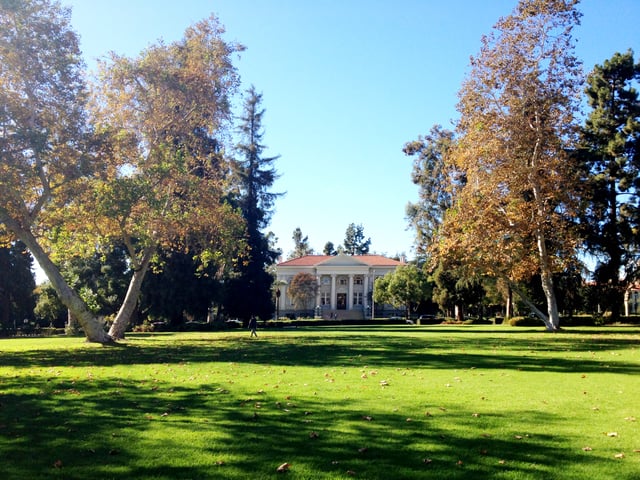
Marston Quadrangle forms the center of Pomona's campus.
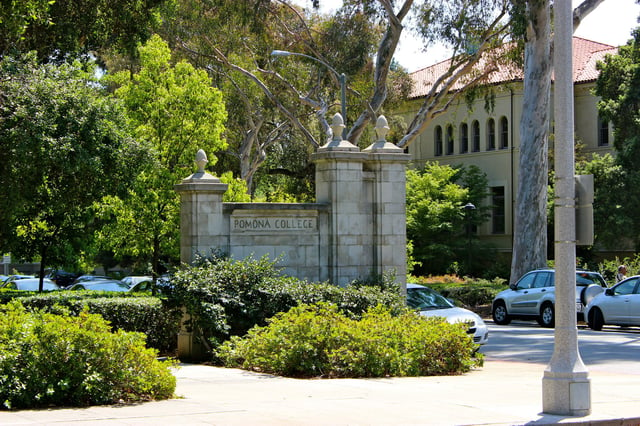
The College Gates originally marked the northern edge of Pomona's campus.
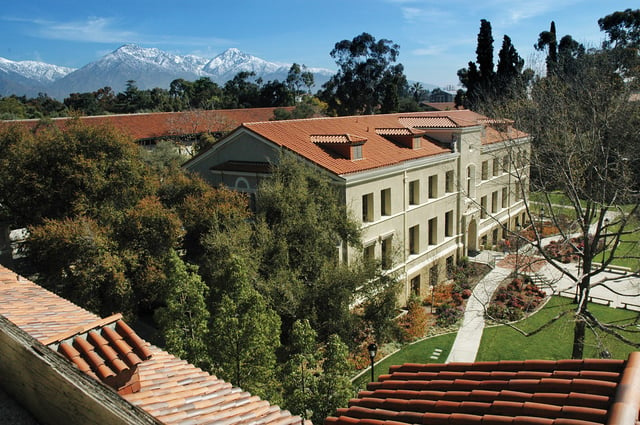
Crookshank Hall is one of the three academic buildings lining the Stanley Academic Quadrangle on the western edge of campus.
Pomona’s campus is in Claremont, California, covering an area of 140 acres (57 ha). It includes 63 buildings, including 14 residence halls.[42] The campus in Claremont began with the donation of an incomplete hotel, that would become Sumner Hall. It quickly expanded from 7 buildings in 1909—the time James Blaisdell took over as President.[43] He purchased the empty land around the College while it was still available, securing the College’s future and allowing for expansion for years to come. First Street borders the campus on the south, Mills and Amherst Avenues to the east, Eighth Street on the north, and Harvard Avenue on the west. Claremont Graduate University, Scripps College and Claremont McKenna College are adjacent to Pomona’s north, from west to east respectively. Pomona is divided into North Campus and South Campus, casually divided by Sixth Street, with a few exceptions. Many of the earlier buildings are constructed in the Spanish Renaissance Revival and Mission Styles, and are of only one or two stories in height. Bridges Hall of Music, designed by Pasadena architect Myron Hunt, is an example of the fusion of these two styles.[44] Later buildings took inspiration from these styles, encompassing usually three or fewer stories bounded by stucco walls.
South Campus consists of mostly first-year and sophomore housing and academic buildings for the social sciences and humanities. Among the notable dormitories are Harwood Court, originally a women’s dorm built in 1921, and Oldenborg Center, a foreign language housing option for students that includes a foreign language dining hall.[45][46] Sumner Hall, Pomona’s first building and the home of admissions, financial aid, and housing, is directly across from the dormitories. Bridges Auditorium (referred to as "Big Bridges" to distinguish it from the smaller Bridges Hall of Music) is used for concerts and speakers and has a capacity of 2,500.[47] Bridges Hall of Music ("Little Bridges"), to the east of the departments of Music, Studio Art, and Art History, is a concert hall built in 1915 with seating for 600.[44] Adjacent to the departments of Studio Art and Art History is the Pomona College Museum of Art, which has a small collection of European, pre-Columbian, and American works along with a gallery for traveling exhibitions.[48] The Carnegie Building houses the Politics and Economics departments. It was built in 1929 as a library for the college. Marston Quadrangle serves as a central artery for South campus facilities and is between the Carnegie Building and Bridges Auditorium. It is one of two quadrangles on campus. The Pomona College Organic Farm is hidden behind The Wash on the southeastern corner of campus. The Studio Arts Hall, built in 2015 to Leed Gold Certification, is behind the Oldenborg Center, and garnered national recognition for its steel-frame design.[49]
North Campus is also a mix of residential and academic buildings. Most of the academic buildings house science departments. Among the notable buildings are the Richard C. Seaver Biology Building ("Seaver West"), completed in 2005,[50] the Lincoln and Edmunds buildings, both completed in 2007, the Sontag and Dialynas residence halls, both completed in 2011, and the Millikan Laboratory for Math, Physics, and Astronomy, completed in 2015. North Campus is also home to the Center for Creativity and Collaboration, established in 2015 and colloquially termed as "The Hive".[51]
The Lincoln and Edmunds buildings were the first buildings in Claremont to garner a gold certification award from the U.S. Green Building Council’s Leadership in Energy and Environmental Design (LEED) Program.[52][53] The two new academic buildings also house the first publicly accessible Skyspace art installation by renowned artist and alumnus James Turrell '65.[54][55] Dialynas and Sontag Hall were built to LEED platinum standards, only the second large-scale residence halls in the country to earn that designation by their completion time.[56] Millikan Hall is the first LEED platinum certified science building on campus.[57]
North Campus dormitories house mostly juniors and seniors. Smiley Hall was built in 1908 and the college claims that it is the oldest lived-in dorm in the Western United States.[58][59] Frary Dining Hall, one of two dining halls on campus, is the location of the murals "Prometheus" by José Clemente Orozco, his first work in the US, and "Genesis" by Rico Lebrun.
Along the south side of Sixth Street are buildings central to the campus. Smith Campus Center is home to many student services, including a mailroom, a recreation room, The Coop Store, and two restaurants;[42] Alexander Hall houses administrative offices. Athletic facilities are to the south of Sixth Street and to the east of Smiley Hall. The Rains Center is the main athletic facility with a fitness center, gym and locker rooms. Adjacent to Rains Center is Merritt Football Field, Alumni Baseball Field and Haldeman Pool. A parking structure on First Street serves as a parking space for 600 vehicles and a soccer and lacrosse field.[60]
Other Pomona facilities of note include the student group and lounge in Walker Hall known as the Women's Union, the Claremont Colleges' radio station, KSPC 88.7fm, in the basement of Thatcher Music Building, the Sontag Greek Theatre—an outdoor amphitheater, as well as The Farm, an experiment in sustainable farming, and the Seaver Theatre Complex, built in 1990 with a 335-seat auditorium, 100-seat experimental theater and several other studios and rehearsal spaces. Another notable resource is the Robert J. Bernard Field Station north of Foothill Boulevard, and the Trail Ends Ranch, 3.9 miles (6.3 km) away from campus and owned by Pomona College.[61]
Along the north side of campus are several joint buildings maintained by the Claremont University Consortium. These include the Tranquada Student Center, home to student health and psychological services, Campus Safety, and the Huntley Bookstore. Honnold-Mudd Library, the joint Claremont Colleges library, holds 2 million volumes, 60,000 periodicals, 30,000 reels of microfilm, and over 1 million microfiche and microcards.[62]
The southern side of campus is next to the Claremont Village, and 2 blocks north of the Claremont Metrolink Station. The campus is less than five miles (8.0 km) south of the San Gabriel Mountains, on top of the alluvial fans that have come from nearby San Antonio Canyon.
Academics and Programs
Curriculum
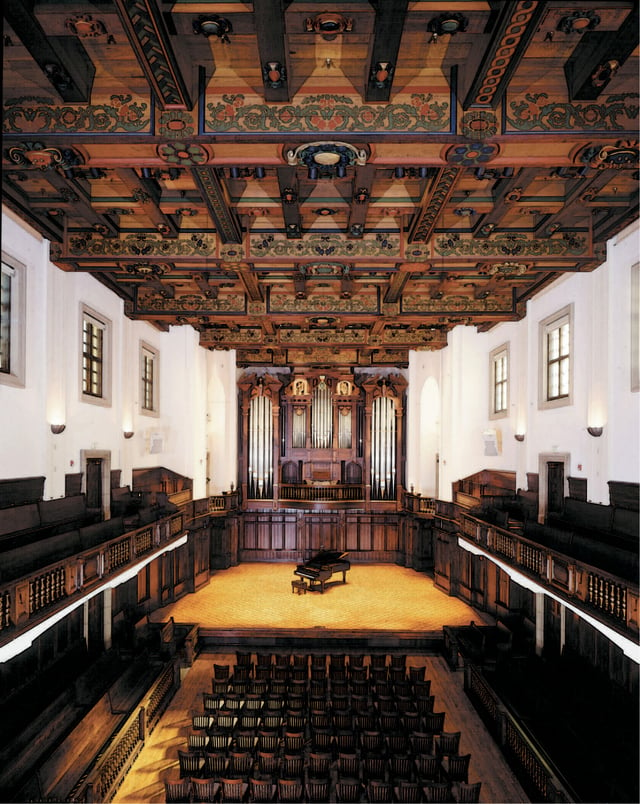
Bridges Hall of Music hosts a variety of performances by the college's musical ensembles.
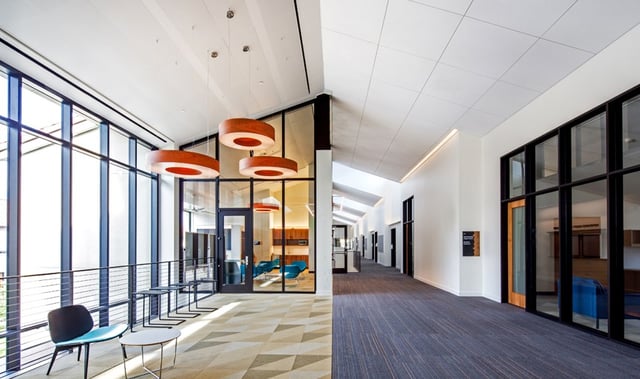
Millikan Hall, opened in 2015, houses Pomona's physics, math, and astronomy departments.
Pomona operates on a semester system. Students generally enroll in four full-credit courses each semester, though they can take up to six provided they have good academic standing. Thirty-two credits are needed to graduate from the college, along with the requirements of a major, the first year Critical Inquiry seminar, six courses within the "Breadth of Study" area requirements, proficiency in foreign language, two physical education courses, a writing intensive course, a speaking intensive course, and an analyzing difference course (the last three can fulfill the Breadth of Study or major course requirements simultaneously).[63]
The average class size at Pomona is 15. Of the 404 traditional courses (i.e., excluding thesis, lab sections, and independent study courses) at Pomona offered in Fall 2017, 93% had under 30 students, and only two courses had 50 or more students.[3] All classes are taught by professors, and there is an 8:1 ratio of students to full-time professors.[64] Eighty-five percent of faculty live within five miles (8.0 km) of campus, and each faculty member has two meal swipes each week, which they often use to interact with students.[65]
Any student attending Pomona can enroll in up to 50% of their classes at the other four colleges in the Claremont Colleges. This policy is similar across the Claremont Colleges; it is meant to give students the resources of a larger university while maintaining the positive qualities of a small liberal arts college. The academic calendars and registration procedures across the colleges are synchronized and consolidated, and there are no additional fees for taking courses at another college. In total, Pomona students have access to over 2,700 courses each year, including graduate level courses at the Claremont Graduate University and Keck Science Institute.[66] In addition, students from any department can create independent study courses evaluated through the guidance of individual faculty mentors, with a limit of one course per semester in the first and second year, and two per semester in the third year and after.[67]
Pomona has 48 majors and 44 minors; students who would like to create their own major are eligible to do so following specific guidelines. The 10 most popular declared majors for Fall 2018, in order, are: Economics (118 students), Computer Science (91), Mathematics (67), Neuroscience (58), Politics (42), International Relations (41), Public Policy Analysis (41), Molecular Biology (39), Media Studies (38), and Psychology (32). The most popular major for Class of 2018 graduates was Economics, and approximately 15% of them received a double-major.[68] While engineering is not directly offered by the college, students are eligible to cross-register at Harvey Mudd College or to pursue a combined engineering plan in collaboration with California Institute of Technology, Washington University in St. Louis, and Dartmouth College. Pomona College also offers a teaching credential program with the Claremont Graduate University and is a partner school with the Harvard Business School HBX-CORe program.[69][70]
49% of Pomona students study abroad.[71] Pomona offers 62 pre-approved programs in 34 countries.[72] Students can study abroad in any major, and can petition to study abroad in an outside program. The college has a semester study-away program in Washington D.C. and the Silicon Valley offered through consortium member Claremont McKenna College, as well as a semester program in environmental science sponsored by the Marine Biological Laboratory. In addition, students can do a semester-exchange at Colby College, Spelman College, and Swarthmore College.[73]
Pomona spent an average of $300,095 in educational spending per degree completion as of 2013, ranking it the highest among all peer liberal arts colleges for educational spending per capita and in the top 25 of all four-year private non-profit colleges and universities. For comparison, the average California four-year private non-profit spent $125,902, and the average among all four-year private non-profits in the US was $101,725.[74]
Professional development
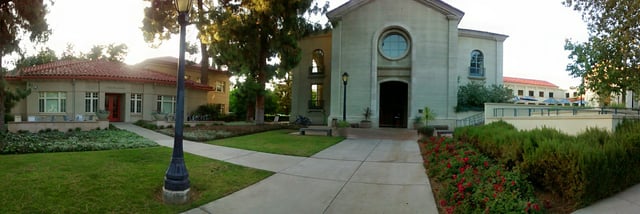
Pomona's Career Development Office (left) is located in Alexander Hall.
The majority of faculty work with one or more students on research projects in a variety of academic disciplines.[75] 53% of students do research with faculty, and the College sponsors a subsidized Summer Undergraduate Research Program (SURP) for its students every year.[71] Students may choose to either work side-by-side with professors, or pursue their own independent projects.[76] For the summers of 2012 and 2013, more than 460 students were involved with summer research.[77] Many students also work with professors or do independent research during the school year. In addition, the Howard Hughes Medical Institute (HHMI) summer research program sponsors a consortia college summer research program, enabling Pomona students to participate in research opportunities at the other Claremont Colleges. Pomona was named by The Wall Street Journal as one of ten institutions where "Great Research Meets Great Teaching".[78]
The Pomona College Career Development Office provides pre-professional opportunities. The Pomona College Internship Program (PCIP) connected 134 students in the 2014–2015 year to paid internships undertaken during the school year at 102 different organizations in Southern California. Students receive a wage as well as transportation funding. The Summer Experience Funding (SEF) program provides funding for students with unpaid or low paying summer internships, including international internships. For the 2015–2016 year, 103 students received these awards in 90 sites, including 21 international internships; destinations included the United States Department of the Treasury, United Nations, Sony Entertainment Television, Ernst & Young, American Enterprise Institute, the International Criminal Court, and the Smithsonian, as well as academic experiences at research universities including UCLA, Caltech, UC Berkeley, Carnegie Mellon, and Stanford. The Shadow a Sagehen program enables current students to shadow alumni during winter break, the Sagehens in Residence program brings alumni to speak to students on campus, and the SagePost47 program links students to young alumni on a virtual platform for mock-interviews and networking. In addition, Pomona participates in Winter Career Recruiting, which provides travel funds for students applying for full-time positions and summer internships offered by companies based in Boston, New York City, Washington DC, and Los Angeles.[79] By graduation, 89% of Pomona students have completed at least one internship experience; 70% have completed two or more.[80]
Pomona collaborates with the other Claremont Colleges and consortia such as Selective Liberal Arts College Consortium (SLAC), Career and Intership Connections (CIC), and Liberal Arts Career Network (LACN). Most career based events are five college in nature, enabling students to attend a larger diversity of events than would be available at a single liberal arts college. The online HandShake program contains over 9,100 job postings, and the LACN database contains over 13,000 postings. 175 employers hosted on-site informational events at the Claremont Colleges, 265 unique organizations were represented in 9 career fairs, and 150 employers participated in interview and on-campus recruiting specifically for Claremont College students.[79]
Outcomes
Within 10 years, 83% of Pomona graduates attend graduate and/or professional school.[71] Examples of destinations for students in the Class of 2017 immediately following graduation included Cambridge University, Stanford University, Cornell University, University of Southern California, UCSF, UCLA, Yale University, Harvard University, and Columbia University. Among Pomona applicants applying to medical school in the 2018 cycle, the percent accepted stood at 85%, more than twice the national average of 32%.[81][82] A 2016 study by College Transitions listed Pomona as among the 20 best colleges and universities for sending students to the top-ranked medical, business, and law schools per capita, as analyzed by LinkedIn profiles of alumni.[83][84][85] Pomona ranks 12th among all colleges and universities for graduates receiving doctoral degrees on a size adjusted basis from 2006–2015, as well as 12th among those receiving STEM doctoral degrees alone.[86]
Payscale ranked Pomona College 45th among colleges and universities (and 13th among liberal arts colleges) for its 2017–2018 Salary Report, with graduates earning an average early career salary of $60,600 and an average mid-career salary of $130,100.[87] Graduates from the Class of 2016 reported accepting full time positions at National Institute of Health, Google, Amazon, Apple Inc., Boston Consulting Group, Bank of America Merrill Lynch, Morgan Stanley, McKinsey & Company, Deloitte, Goldman Sachs, ABC Studios, Royal Bank of Canada, Lyft, LinkedIn, Harvard Medical School, Alphabet Inc., Fidelity Investments, Latham & Watkins, and Equinix, alongside numerous other destinations.[79] Pomona has been recognized as a major contributor among small colleges sending alumni to the Teach for America program, and it ranks among the top 50 U.S. colleges and universities for producing career diplomats.[88][89] In a study on student debt produced by the Project on Student Debt for the Class of 2011, Pomona College was among the top 20 colleges and universities in the least amount of debt taken on by graduates.[90]
In a 2015 bulletin published by the Churchill Scholarship foundation, Pomona ranked as the liberal arts college with the highest number of students awarded the scholarship from 2005–2015, and fifth among all colleges and universities alone, tied with the California Institute of Technology and Carnegie Mellon University.[91] It also ranked as the liberal arts college with the largest number of students and alumni receiving National Science Foundation graduate research fellowships in 2017, with a total of 14 recipients.[92] Since 1904, 12 Pomona alumni have received Rhodes Scholarships, the third most of any California college or university after Stanford University and University of California: Berkeley (Rhodes Scholarships are distributed equally among each state).[93] 13 Pomona alumni have received Marshall scholarships since 1954, the third highest among liberal arts colleges and within the top 40 colleges and universities overall.[94] From 2012–2017, six students and alumni received Gates Cambridge Scholarships.[95] From 2008–2017, Pomona produced the most Barry M. Goldwater Scholarship recipients of any primarily undergraduate institution, with a total of 20 students.[96][97] The college ranked second among all liberal arts colleges for students winning Fulbright Scholarships in the 2016–2017 cycle, tied with consortium member Pitzer College.[98] Out of the quarter of the Class of 2017 who applied for fellowships in their senior year, 28 students received a total of 31 awards, including 13 Fulbright awards, 2 Downing Scholars in Downing College, Cambridge, 1 Watson Fellowship, 1 Princeton in Asia Fellowship, and 2 NYU Shanghai Teaching Writing and Speaking Fellowships.[81]
Rankings
The 2019 U.S. News & World Report college rankings categorize Pomona as "most selective" and rank it tied for the 5th best liberal arts college in the nation (along with 2nd for "Best Value").[103] Pomona has been ranked in the top 10 liberal arts colleges every year by U.S. News ever since it began ranking them in 1984, and is one of only five schools with such a history.[104]
In 2019, Forbes ranked Pomona 12th overall in its America's Top Colleges ranking,[12] which includes 650 military academies, national universities, and liberal arts colleges, and first among liberal arts colleges alone.[105] In 2015, it ranked Pomona first among all colleges and universities in the U.S.[106]
The Wall Street Journal/Times Higher Education 2018 rankings rated Pomona 24th out of over 1000 U.S. colleges and universities, and 3rd among liberal arts colleges alone.[107]
Parchment ranked Pomona first among all colleges and universities in its 2017 Student Choice College Rankings, a measure of admitted students' revealed preferences among their college choices.[108]
The Princeton Review has included Pomona in several of its rankings over the last few years, including best value colleges, best classroom experience, best financial aid, best run schools, most loved schools, most accessible professors, best quality of life, happiest students, best college dorms, and best science facilities.[109][110][111]
Admissions and financial aid
Admissions
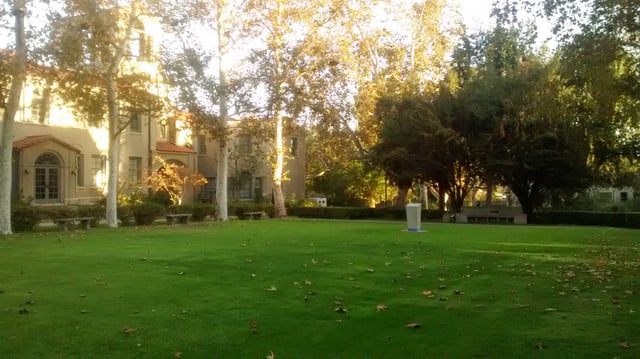
Pomona College's office of admissions is located in Sumner Hall.
Pomona offers three routes for students to apply: the Common Application, the QuestBridge application, and the Coalition application.[114] Applicants who want an earlier, binding decision to the college can apply either Early Decision I or II; others apply through Regular Decision.
The college considers a variety of factors for the admissions process, placing greatest importance to course rigor, class rank, GPA, test scores, application essay, recommendations, extracurricular activities, talent/ability, and character/personal qualities. Interviews, first generation status, alumni relation, racial/ethnic status, volunteer work, and work experience are considered. Geographic background, religious affiliation, and the applicants' level of interest are not considered.[3]
For the 2018–2019 admissions cycle, Pomona College accepted 780 students from a pool of 10,245 applicants (a 7.6% overall acceptance rate).[10] Fifty-seven percent of the admitted students were domestic students of color, 11.3% were international students, and 19.2% were first-generation college students. Ninety-five percent were in the top decile of their class. The median SAT for admitted students was a 1495 (735 Evidence Based Reading & Writing; 760 Math), and the median ACT was a 34. Admitted students represented 47 states, District of Columbia, Puerto Rico, Guam, and 44 foreign countries; approximately a quarter were from California.[14]
Pomona is also a Posse Foundation partner college, and is part of many coalitions and initiatives targeted at bringing underrepresented demographics to higher education. Domestic programs include the Say Yes Education Compact, which offers full-tuition scholarships to students from urban school districts, the American Talent Initiative, a group of 86 colleges and universities seeking to "expand access and opportunity for highly-talented lower-income students", and Service to School's VetLink program, a group of 14 leading universities and liberal arts colleges seeking to support veteran applicants in the admissions process.[116][117][118] International initiatives include the Sutton Trust, which identifies high-achieving low-income students in the United Kingdom to study in U.S. colleges, Bridge2Rwanda, a non-profit seeking to increase access of U.S. colleges to Rwandan students, and the Grew Bancroft Foundation, an organization seeking to connect Japanese students to U.S. liberal arts colleges.[14][119][120]
Costs, financial aid, and socioeconomic impact
Pomona practices need-blind admission for students who are U.S. citizens, permanent residents, DACA status students, undocumented students, or who graduate from a high school within the United States, and meets 100 percent of demonstrated need for all admitted students, including admitted international students.[121][122] No loans are packaged in the financial aid package, though students can choose to borrow if so desired.[123] No merit awards or athletic scholarships are offered by Pomona.[124]
For the 2018–2019 school year, Pomona charged a sticker price (tuition, room and board, and associated fees) of $69,496. Over $50 million in need-based scholarships was awarded in 2018. Fifty-seven percent of students received a financial aid package, with an average award of $55,390. Eighty-nine international students, representing 47% of all international students enrolled at the college, received an average financial aid award of $59,477.[10] The college was named 1st in the 2017 Edition of the Princeton Review for "Best Financial Aid".[125]
Twenty-two percent of Pomona College students qualify for Pell Grants, a federal financial aid grant reserved for domestic students of the neediest backgrounds. A 2017 review among top 50 LACs (as ranked by US News & World Report) identified Pomona as having the third highest Pell population as a percent of the first year class, after Soka University of America and Vassar College.[126] According to a 2018 report by Third Way, Pomona was one of five colleges or universities (among 1566 analyzed) to graduate 100% of Pell Grant recipients within six years, considerably above the national graduation rate of this group at 51%.[127] In 2017, The New York Times listed Pomona at #8 among "Top Colleges Doing the Most for the American Dream", based on net-prices for middle-income students and Pell percentage; Amherst College and Harvard University were the only other private institutions within the top 10.[128]
People
Student body
| Category | Percent |
|---|---|
| White, Non-Hispanic | 34.5% |
| Hispanic/Latino | 17.3% |
| Asian, Non-Hispanic | 15.0% |
| Black, Non-Hispanic | 9.7% |
| Native American or Pacific Islander, Non-Hispanic | 0.6% |
| International, Non-Hispanic | 11.4% |
| Two or more races, Non-Hispanic | 6.9% |
| Race or ethnicity unknown | 4.5% |
As of Fall 2018, the student body consists of 1679 undergraduate students, of whom 1655 are degree-seeking students. Of degree seeking students, 52.1% of the students are female and 47.9% are male. 49.5% are domestic students of color, and an additional 11.4% are international students.[20] Current Pomona students hail from all 50 states, D.C., Puerto Rico, Guam, and 59 foreign countries.[7] The most frequent hometowns for Pomona students enrolled for the 2017–2018 year were in California (26.5%), foreign countries (15.2%), Illinois (6.1%), Washington state (4.7%), and New York (4.7%).[129]
The first-year class consists of 412 students. In addition, 22 transfer students matriculated. The middle 50% of enrolled first-years scored a 700–760 on the new SAT evidence based reading and writing Section, 700–780 on the new SAT math section, and 31–34 on the ACT; 91% ranked in the top 10% of their high school class, while 100% ranked in the top 25% (among students with an official class rank).[10]
For the Class of 2012, 88% of students graduated within 4 years, and 94% graduated within 6 years. The retention rate for the Class of 2021 was 96.90%.[10] U.S. News reported that Pomona had the highest four year graduation rate of any college or university in the USA for students entering in Fall 2010, as well as the highest retention rate of any liberal arts college from Fall 2012–2015.[130][131]
Alumni and faculty

U.S. Senator Brian Schatz (D-HI) graduated from Pomona in 1994.

Actor Joel McCrea in still from Woman Wanted (1935)
Pomona has nearly 25,000 living alumni. Of those who are working, 23.5% are in education, 23.8% are in business and finance, 10.4% are in law and government, 9.9% are in health and medicine, 4.3% are in science and technology, 5.1% are in arts and media, and 23% are in other fields.[42]
Of the 241 faculty members, 188 are full-time faculty and 53 are part-time faculty. Of full-time faculty, 60 (31.9%) are members of minority groups, 79 (42%) are women, and 186 (98.9%) have a doctorate or other terminal degree in their respective field.[132]
Notable alumni of Pomona College include historical cartographer Carl I. Wheat (1915); fourteen-time Grammy Winning conductor Robert Shaw (1938); Gumby creator Art Clokey (1943); The Walt Disney Company executive Roy E. Disney (1951); writer, actor, and musician Kris Kristofferson (1958); actor Joel McCrea (1928); actor Richard Chamberlain (1956); California politician Cristina Garcia, light and space artist James Turrell (1965); Civil Rights activist and NAACP chairman Myrlie Evers (1968); former New York Times executive editor Bill Keller (1970); Pulitzer Prize-winning newspaper columnist Mary Schmich (1975);[133] Berkeley biologist Jennifer Doudna (1985); American Neo-Nazi Alex Linder (1988); first Muslim judge in California Halim Dhanidina (1994); Judge of the U.S. Court of Appeals for the Federal Circuit Richard Taranto (1977); U.S. Senator for Hawaii Brian Schatz (1994); and several Academy Award-winning screenwriters, including Robert Towne (1956).
Notable faculty of the past and present include the late novelist David Foster Wallace, former U.S. ambassadors Cameron Munter and Michael Armacost, novelist Jonathan Lethem, jazz musician Bobby Bradford, German historian Golo Mann, poet Claudia Rankine, president of the National Association of Mathematicians Edray Goins, composer Fannie Charles Dillon, and NBA basketball coach Gregg Popovich, who mentored alumnus Mike Budenholzer.
Student life
The Claremont Colleges
Pomona is a member of the Claremont Colleges, and most social activities revolve around the five colleges, or "5Cs". Pomona College, Claremont McKenna College, Scripps College, Pitzer College, and Harvey Mudd College share dining halls, libraries, and other facilities throughout the contiguous campuses. All five colleges, along with Claremont Graduate University and the Keck Graduate Institute, are part of the Claremont University Consortium. Notable benefits of being in the consortium include equal access to seven dining halls and 10 additional on-campus eateries, the fifth largest private library collection in California, interaction with over 7,000 students, access to programs such as Harvey Mudd's Clinic Program and Claremont McKenna's Semester in Washington (DC) program, and the opportunity to do a housing exchange with a student at another college.[134] Most events sponsored by each school are open to students from all of the Claremont Colleges, including invited speakers and performers, employment and recruiting events, and social events.
Campus organizations

Pomona College in winter
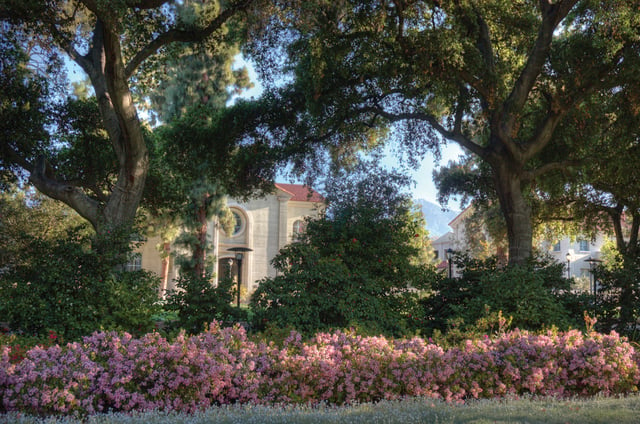
The Smith Campus Center houses the offices of the Pomona's student government.
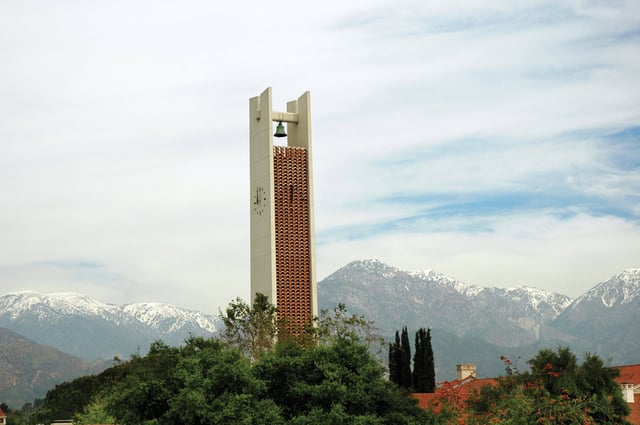
On The Loose, the outdoors club of the Claremont Colleges, organizes frequent hikes in the San Gabriel Mountains north of campus.
There are more than 200 clubs and organizations across the Claremont Colleges.[135]
There are several media organizations at the Claremont Colleges, including most prominently The Student Life, the oldest college newspaper in Southern California.[136] It publishes a weekly print edition as well as online content. The Claremont Independent, a conservative magazine, has produced articles about the campuses' political culture that have been picked up by national conservative media outlets and drawn criticism from many students.[137][138][139][140] The Golden Antlers publishes satirical content.[141] The Claremont Radius is a student publication whose aim is to "spark political discourse" through 2 or more writers who argue for or against a specific political issue.[142] Pomona also has a student-run radio station, KSPC.
The Associated Students of Pomona College (ASPC) serves as Pomona's official student government. Composed of fifteen elected representatives and numerous appointed committee members, ASPC represents Pomona's student body in discussions with the administration, provides funding for clubs and organizations, runs the Pomona Events Committee (PEC), and covers the cost of security and alcohol for social events. It also manages a New York Times subscription program and an airport ride coverage program.[143]
Pomona Events Committee (PEC) is a committee of ASPC, and creates on-campus and off-campus events for Pomona students. Some notable events include De-Stress, which provides students a relaxation period before final exams; the annual Ski Beach Day, in which students spend a day at a nearby ski resort followed by a trip to a local beach, subsidized excursions to attractions and venues in the Los Angeles region, and dances such as the Yule Ball and the Spring Formal.
The Pomona Student Union (PSU) facilitates the discussion of political and social issues on campus. They describe their mission as "promoting honest and open dialogue in order to challenge the assumptions of students and the wider campus community."[144] They hold discussions, panels, and debates with prominent speakers with the goal of stimulating conversation and creating an environment in which all viewpoints are represented. Notable speakers the PSU has brought to Pomona include Jon Meacham, Mari Matsuda, Sam Harris, Nadine Strossen, Michael Isikoff, and Slavoj Žižek[145].
The Claremont Colleges Ballroom Dance Company (CCBDC) is one of the largest organizations on campus, with over 130 dancers. It offers dance classes on a variety of expertise levels and showcases several events and performances each year.[146] CONTRAversial, the contra dance club of the Claremont Colleges, hosts monthly dances that are open to both students and community members.[147][148] Other dance groups include the 5C Dance Company, hip-hop dance crews Groove Nation and Reverb, Tamasha (5C Bollywood Dance Company), 5C Ballet Company, Underground Blues, and 5C Freestylin' Collective.
On the Loose (OTL), the outdoors club of the 5Cs, sponsors trips to outdoors destinations.[149] It is affiliated with the Outdoor Education Center of the Claremont Colleges (OEC), which loans equipment to students for free and provides outdoor leadership training.
Pomona has numerous singing and a cappella groups, including Men's Blue and White, Women's Blue and White, the After School Specials, the Claremont Shades, Midnight Echo, the 9th Street Hooligans, Kosher Chords, and Mood Swing. It hosts the annual SCAMFest concert, which also draws in a capella singers from other Southern California universities, as well as the regional quarterfinals for the International Championship of Collegiate A Cappella. Other musical groups include the Pomona College Orchestra, Band, Choir, Glee Club, Jazz Ensemble, and Balinese Gamelan Ensemble. All Pomona College students, and Claremont College students in Pomona College ensembles, can receive private music lessons at no cost.[150] The Pomona College Theater Department leads 3–4 mainstage productions each year, and there are a number of smaller student run productions as well. The college also hosts an improv group, Without a Box.
Pomona has two remaining local Greek organizations, Sigma Tau and Kappa Delta, both of which are co-educational.[151] Neither have special housing, and they are not considered to have a major impact on the social scene on campus.
Sagehen Capital Management, Pomona's student-run hedge fund investment club, manages assets of over one million dollars from the college's endowment.[152]
Pomona is home to numerous student support offices, which provide mentoring programs to ease the transition for students who identify with a particular identity. These include the Women's Union (WU), Office of Black Student Affairs (OBSA), Asian American Resource Center (AARC), Students of Color Alliance (SOCA), Chicano Latino Student Affairs (CLSA), Queer Resource Center (QRC), and the International Place of the Claremont Colleges (I-Place).[153] The low-income and first-generation community on campus, Quest Scholars, has over 160 active members and provides all incoming first year low income students with upperclassman mentors.[154] The Pomona Advocates support survivors of sexual violence and work to promote consent culture.[155]
Club and intramural sports
Athletic facilities at Pomona include five basketball courts, four racquetball courts, two squash courts, a weight room, an exercise room, 2 pools, 2 tennis court complexes, a football field, a track, a softball field, a baseball field, and four fields for soccer, lacrosse, ultimate frisbee, and field hockey.[158]
Residential life
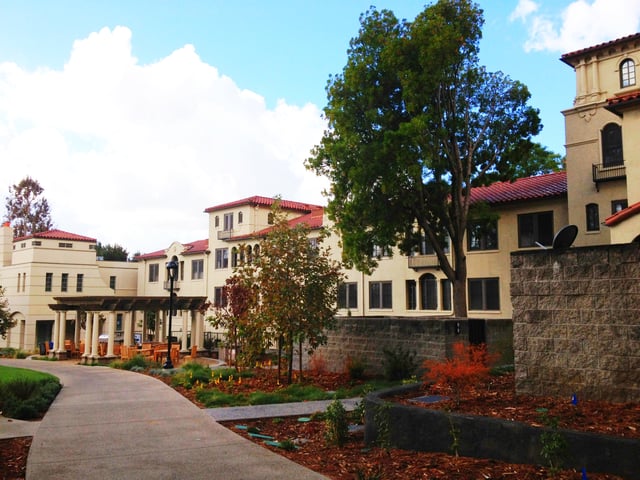
Harwood Court, a south campus residence hall
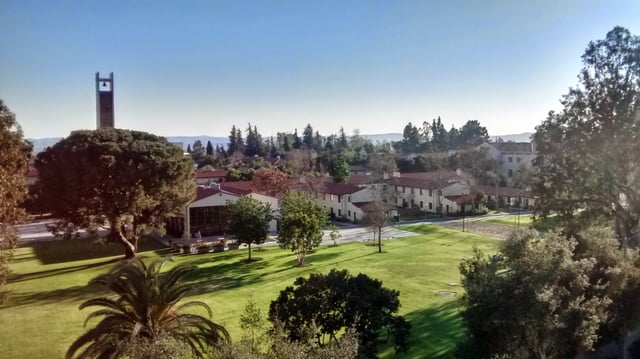
Walker Hall is one of the residence halls located on North Campus.
Pomona is a residential campus, and students must apply to live off campus. Virtually all students live on campus for all four years in one of Pomona's sixteen residence halls:[159]
- South Campus
All first-year students live on South Campus. All first-years are placed into a sponsor group, with 10–20 other first years and two or three upperclassmen "sponsors". This is meant to ease the transition for incoming students.[160]
Mudd-Blaisdell is Pomona's largest residence hall. It is home to 280 students living in doubles and singles. It is the only air-conditioned hall that houses first years.
Harwood Court houses 170 students. It was built in 1921, is the oldest residence hall on South Campus, and the second-oldest west of the Mississippi (after Smiley).
Wig Hall was built in the 1960s and houses 113 students, primarily first-years, mostly in doubles.
Lyon Court houses 78 students, mostly in doubles.
Oldenborg Center is home to 140 students, mostly sophomores. Oldenborg residents live in language or special interest halls, and are expected to participate in the Center's extracurricular activities, which include foreign language film series, speakers, and other activities. Oldenborg also contains a foreign language dining hall, which serves lunch Monday through Friday. The Center is air-conditioned.
Gibson Hall houses 36 students in mostly doubles. It is located in the Mudd-Blaisdell Courtyard.
- North Campus
Most residents of North Campus are juniors and seniors.
Smiley Hall is Pomona's oldest residence hall, and the oldest west of the Mississippi River. It was built in 1908 and houses 60 students, all in singles.
Walker Hall houses 112 students in singles and two-room doubles. First-year transfer students live in Walker.
Clark I contains two five-person suites, as well as two-room doubles. One hundred sixteen students live in Clark I.
Clark V has space for 95 students in singles and two-room doubles.
Norton-Clark III is home to 120 students in singles and one- and two-room doubles.
Lawry Court consists of three towers, each of which has three floors. Each floor contains eight single rooms around a common room and bathroom. 71 students live in Lawry Court (the first floor of the B tower has an electrical room).
Sontag Hall is a three-story building that has approximately 150 single rooms in suites containing three to six students per suite. Most occupants are seniors, though some sophomores and juniors also reside in Sontag Hall. Dialynas and Sontag Halls were completed in 2011, making them the newest residence halls.[161]
Dialynas Hall matches Sontag Hall in space, LEED certification, and how sustainability is implemented. Dialynas Hall also houses the Outdoor Education Center and has a rooftop classroom.
Transportation
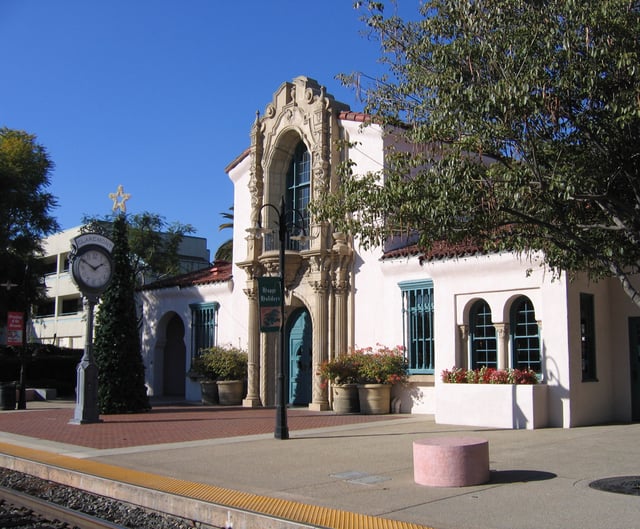
Claremont's train station is located two blocks south of campus, and provides direct access to downtown Los Angeles.
Pomona's campus is located two blocks from the Claremont Station, where the Metrolink San Bernardino Line train provides daily service to Union Station, Los Angeles. The ride from Claremont to Los Angeles takes a little under an hour, and college students are eligible to receive a 25% discount on fares. Metrolink tickets from Claremont serve as an all-day "EZ-Transit Pass", enabling users to connect to participating bus and rail lines for free for the duration of the day. This grants access to the bus and light rail system of LA Metro and LADOT, the two largest public transportation systems in the region, alongside numerous other public transportation systems.[162]
The campus is also two blocks from the Claremont Transcenter, serviced by bus system Foothill Transit. Bus lines connect to cities in the San Gabriel Valley and Pomona Valley. The nearby Montclair Transcenter provides connections to Omnitrans, the largest public transportation system in San Bernardino county, and the Foothill Transit Silver Streak, which runs to Downtown Los Angeles at least once every hour (including late-night). All Pomona students and employees receive a free Foothill Transit Class pass, enabling unlimited free rides on any Foothill Transit Bus, including the Silver Streak.[163]
The Green Bikes program at Pomona allows students to check out a bicycle free of charge for the duration of the semester, and provides free bicycle servicing and repair to all employees and students. More than 300 bicycles are available.[164]
Through the Zipcar program, students can reserve cars located on-campus for travel within 180 miles. A membership with the program is required, and hourly and daily rates apply. In addition, the college owns vehicles which can be checked out for club and extracurricular purposes, pending approval as a registered driver. PEC and Smith Campus Center off-campus events are usually served with Pomona's 34-passenger bus, the Sagecoach.[165]
Sustainability
Pomona's Board of Trustees adopted the College's first Environmental Policy in 2002.[166] The school subsequently hired its first Sustainability Coordinator in 2008 and its Sustainability Integration Office was created in 2009.[167] The College buys local and organic food for its dining halls, has undertaken a variety of outreach initiatives; requires that all new construction meet LEED Silver standards; offsets a percentage of its emissions with Renewable Energy Credits; and reduces water consumption, especially in landscaping.[168] The College was awarded an "A" for its sustainability initiatives by the Sustainable Endowments Institute in the College Sustainability Report Card 2011.[169]
Pomona College Organic Farm
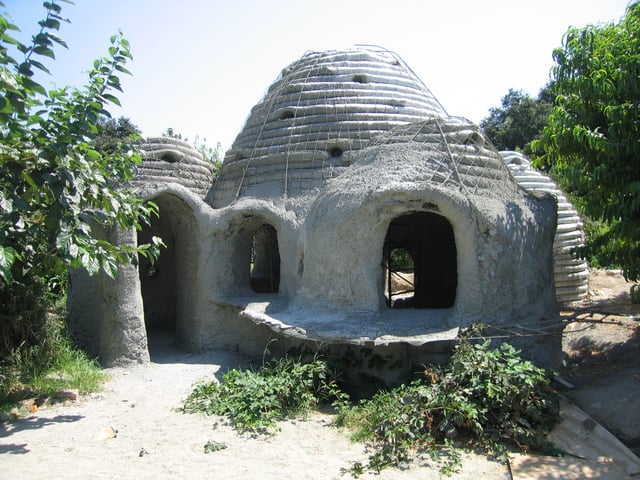
The Earth Dome II during construction in summer 2005
Although initially opposed by the college's administration, it has since been embraced and today grows some of the food used in Pomona's dining halls, composts dining hall waste, and facilitates a popular course on agriculture.
The Earth Dome II Project has redefined the scope and community base of the farm. A group of students and community members built an earth dome at the farm. The foundation was poured in 2004, and the main structural elements of the dome were completed by students and community members during the 2004–2005 school year.
Community engagement
The Draper Center for Community Partnerships, established in 2009, serves as Pomona's community engagement center.[172] The center provides students funding for summer and winter engagement, transportation costs for volunteering during the school year, leadership opportunities through which students can lead the various programs offered (known as Draper Center Coordinators), and advising for community engagement applications.[173] It also provides students, faculty, and local residents a multitude of community engagement programs, including:[174]
Pomona Academy for Youth Success (PAYS), a three-year, pre-college summer program for local low income, first generation students of color[175]
Alternabreak, a week-long community engagement trip for students during Spring Break, at Los Angeles, San Francisco, or San Diego.
ESL Tutoring for local students
Food Rescue, which collects leftover food from the dining halls and delivers it to local shelters
Learning in Collaboration, in which volunteers tutor students from local, under-resourced elementary schools
Pomona Partners, which link high school students to a college future
Rooftop Gardening Mentor Program, which seeks to increase awareness of environmental justice and sustainability
Sagehens Engage, which provide Pomona students weekly opportunities to be involved with community work
Athletics
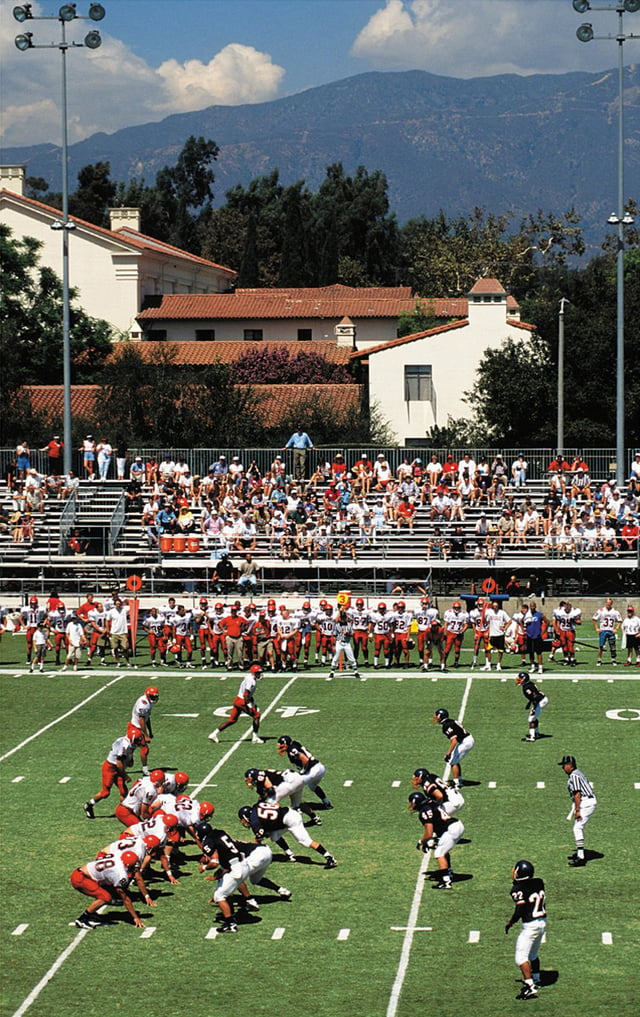
A Pomona-Pitzer football game
The school's athletic program participates in conjunction with Pitzer College (another consortium member) and are named Pomona-Pitzer. The teams participate in NCAA Division III in the Southern California Intercollegiate Athletic Conference. Once known as the Huns, the school's sports teams are now called the Sagehens with their mascot being named Cecil the Sagehen. Their colors are blue and orange.
Athletics history
On October 6, 1923, Pomona College and USC played in the inaugural game at the Los Angeles Coliseum, with the Trojans prevailing 23–7.[176]
The Pomona-Pitzer Sagehens ranked 19th among all Division III schools and second among SCIAC schools in the 2016–2017 Learfield Sports Directors' Cup Division III Final Fall Standings, which ranks athletic programs and awards points relative to their finish in NCAA Championships.[177]
Rivals
The other sports combination of the Claremont Colleges, and Pomona-Pitzer's main rival, is the team made up of Claremont McKenna College, Harvey Mudd College and Scripps College known as the Claremont-Mudd-Scripps Stags and Athenas (CMS).
Traditions
47
The number "47" has historical implications to the college.[179] Two different stories about its roots exist. Campus lore suggests that in 1964, Pomona math professor Donald Bentley produced a convincing mathematical proof that 47 was equal to all other integers, and that other faculty members and senior students could not disprove his equation at first sight. (By the 1970s oral history had grown this tale into a 1950s McCarthy-era exercise by an unnamed professor, and that it was a symbolic attack on the "big lie" political style of the Red-hunters of the era.) Another version — later verified by Bentley — holds that two Pomona students on a summer grant project in 1964 hypothesized that 47 occurred far more often in nature than random number distribution would explain. Pomona College is also located off exit 47 on Interstate 10.
Joe Menosky, a Pomona alumnus and writer for Star Trek: The Next Generation, incorporated the number 47 into a variety of situations in the show.[180]
The 47 tradition is endorsed by the college, as seen in Pomona College's official website's explanation of the "mystery of 47".[179] Various aspects of campus life involve 47, including a celebration every April 7.[181] In the early 2010s, Pomona's clock tower was set up to chime on the 47th minute of the hour.[182][183]
Orientation Adventure
As part of Pomona's 10-day orientation, incoming students spend four days off campus completing an "Orientation Adventure" or "OA" trip. Options in recent year have ranged from backpacking in Sequoia National Forest to sea kayaking in Channel Islands National Park. Begun in 1995, the OA program is one of the oldest outdoor orientation programs in the nation.[184]
Ski-Beach Day
Near the San Gabriel Mountains and within driving distance of the Pacific Ocean, Pomona College takes advantage of its location to host an annual "Ski-Beach Day" each spring. It has been around for at least twenty years. Students board a bus in the morning and are driven to a local ski resort where they ski or snowboard in the morning. After lunch, they are bused down to an Orange County or Los Angeles County beach for the rest of the day.[185]
Mufti
Rooted somewhere in the mists of the 1940s, originally the outgrowth of an unhappy group of women students protesting on-campus policies, Mufti is a secret society of punsters-as-social-commentators. Periodically their name and insignia as well as 3.5 in × 8.5 in (89 mm × 216 mm) sheets of paper are glued to walls all over campus, with double-entendre comments on local goings-on: when beloved century-old Holmes Hall was dynamited to make way for a new building in 1987, the tiny signs all over campus announced "Blast of a Century Leaves Thousands Holmesless."[186]
